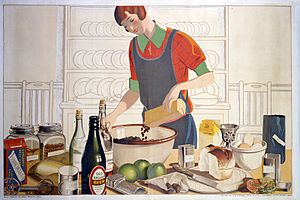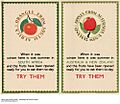Empire Marketing Board facts for kids
The Empire Marketing Board (EMB) was a special group created in May 1926. Its main goal was to encourage people in Britain to buy products from other parts of the British Empire. This included countries like Canada, Australia, New Zealand, and many others. The idea was to boost trade and help the Empire's economy.
The EMB was started by Leo Amery, who was the Colonial Secretary at the time. It was meant to be a way to support Empire trade without using special taxes on goods from other countries. However, it didn't last very long. It was closed down in 1933 when new trade rules, called imperial preference, were put in place. These new rules changed how trade worked within the Empire. During its time, the Empire Marketing Board didn't manage to greatly increase Britain's imports of products from the Empire.
Contents
What Was the Empire Marketing Board?
The Empire Marketing Board had three main goals:
- To support new scientific research.
- To help with economic studies and understanding markets.
- To advertise and promote trade within the Empire.
In 1925, a group called the Imperial Economic Committee suggested creating the EMB. They wanted to get the public excited about buying goods from the Empire. They believed that spending money on research and advertising would help increase sales of British and Dominion products. The EMB's main purpose was to make Empire goods more popular and better able to compete with products from other countries.
The board wanted to help businesses across the Empire. They aimed to provide scientific knowledge and marketing tips. Stephen Tallents, the secretary of the EMB, explained that they wanted to help producers with everything. This included how to grow crops, how to pack goods, how to transport them safely, and even how to display them in shops to catch a shopper's eye.
Supporting Scientific Research
A big part of the EMB's work and budget went into scientific research. They helped fund 126 projects related to agricultural and medical research. They also published many reports and surveys.
In 1931, Walter Elliot from the Royal Society talked about the EMB's research programs. He mentioned that a lot of money was given to important places like Cambridge University. They also supported the Imperial College of Tropical Agriculture in Trinidad. For example, £65,000 was given to study animal health problems at the Onderstepoort Station in Pretoria. Another £58,000 went to study natural pastures at the Rowett Institute in Aberdeen. A large sum of £160,000 was given to the Low Temperature Research Station at Cambridge. This station worked on keeping food fresh, with a related cold storage facility in East Malling in Kent.
This focus on scientific research was a huge effort. It went hand-in-hand with their advertising campaigns until the EMB closed in 1933. The research covered many different science areas across the Empire.
The EMB also helped connect buyers with producers. They studied different markets to help producers sell their goods. The board hired people who knew a lot about media and advertising. They also asked talented artists to create posters for their campaigns.
Advertising Campaigns
The EMB launched many different advertising campaigns. These included poster campaigns, special exhibitions, and 'Empire Shopping Weeks'. They also gave lectures, hosted radio talks, and sent tours to schools. They even had their own library and placed advertisements in newspapers.
One of the most famous parts of the EMB was its film unit. This unit was led by John Grierson, who is often called the father of modern documentary film. They made about 100 films. Some of these films had names like Solid Sunshine (about New Zealand butter) and Drifters (about North Sea herring). Other films included The Song of Ceylon (about tea), Wheatfields of the Empire, Industrial Britain, and One Family.
The Empire Marketing Board used a lot of advertising to get people to buy Empire goods. They used large, colorful posters to attract consumers. These posters were often designed in a series, like a comic strip, telling a story with pictures or slogans. These posters were put up in over 1700 places across 450 British cities and towns. This advertising was widespread in Britain and also reached the Dominions to a lesser extent.
The messages on the posters were often aimed at men and women differently. For example, posters showed men as 'Empire Builders'. They showed women buying Empire products, especially food. The idea of women as important shoppers was also spread through BBC radio talks in 1928. These talks, done with the EMB, encouraged women to use Empire materials and goods. These advertisements tried to use bright colors and make people feel patriotic. However, not everyone thought the campaigns were effective.
Some parts of the Empire, like Dominions, were not always keen to join the EMB's efforts. The government of New Zealand reported that the poster series were "ineffective as sellers of produce." They felt the campaigns were more about showing the Dominions what Britain was doing, rather than actually selling products. Despite these opinions, the Empire Marketing Board's short campaign did leave a lasting impact through its posters, shopping weeks, radio shows, and other advertisements.
The EMB was closed in September 1933 because the government cut funding. Also, the new system of Imperial Preference was introduced. The film unit from the EMB was moved to the GPO. Later, during World War II, it became the Crown Film Unit.
Today, you can find a collection of the EMB's posters at the Manchester Art Gallery. Some original posters are also at the Victoria Falls Hotel in Zimbabwe and the National Archives of Canada.
Gallery
See also
- Colonial goods store










